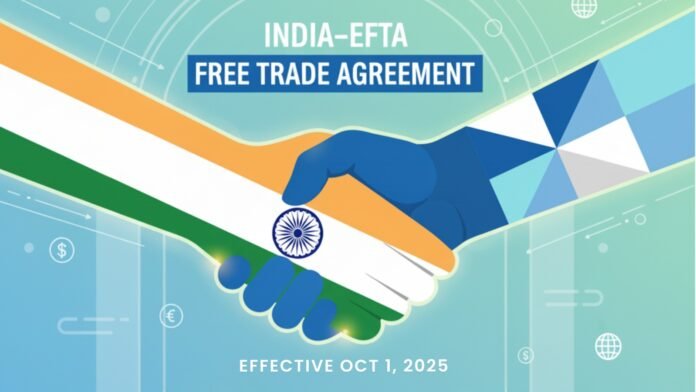India’s long-awaited Trade and Economic Partnership Agreement (TEPA) with the European Free Trade Association (EFTA) — comprising Switzerland, Norway, Iceland, and Liechtenstein — officially came into effect on October 1, 2025, marking a new era of economic cooperation and trade between India and the four EFTA nations.
The agreement, signed in March 2024 after more than 15 years of negotiations, is already reshaping trade, investment flows, and industrial opportunities. It combines tariff liberalization, large-scale investment commitments, and sustainable development provisions, making it one of India’s most ambitious trade pacts to date.
A Historic Deal for India and EFTA
The TEPA is designed to boost bilateral trade, attract foreign investment, and deepen India’s integration with European supply chains. Under the agreement, EFTA nations have pledged USD 100 billion in investments over the next 15 years. The deal is also expected to create one million direct jobs in India, giving a significant boost to employment and industrial growth.
For EFTA, the agreement opens access to one of the world’s fastest-growing markets, offering easier entry for exporters in pharmaceuticals, precision instruments, machinery, and high-end consumer goods.
Key Features of the Agreement
- Investment Commitment: EFTA has pledged USD 50 billion in the first 10 years, followed by another USD 50 billion in the next five years.
- Job Creation: India anticipates at least one million jobs from new investments and industrial expansion.
- Tariff Reductions: Both sides are progressively reducing or eliminating tariffs on a wide range of goods. Indian exports like textiles, pharmaceuticals, and chemicals benefit from preferential access, while imports of Swiss watches, chocolates, and precision equipment into India become cheaper.
- Services Liberalization: The agreement covers services trade, enhancing market access for professionals and businesses in IT, consultancy, engineering, and other sectors.
- Sustainability Provisions: For the first time in an Indian trade deal, TEPA includes legally binding commitments on labor rights, environment, and sustainable development.
Now That the Agreement is in Effect
- Cheaper Imports: Indian consumers are already seeing lower prices on popular EFTA products such as Swiss chocolates, luxury watches, and medical devices.
- Boost for Indian Exports: Indian goods now enjoy preferential access to high-value EFTA markets, enhancing competitiveness for pharmaceuticals, textiles, and machinery.
- Technology & Innovation Transfer: Large-scale investments are expected to bring advanced technology and stronger supply chain linkages to Indian industries.
- New Opportunities for SMEs: Small and medium enterprises in India are positioned to benefit from joint ventures, partnerships, and integration with EFTA firms.
The Road Ahead
The India–EFTA agreement is more than just trade — it’s about building long-term economic trust and cooperation. With investments starting to flow, India can expect a surge in industrial activity, innovation, and employment.
By balancing domestic sensitivities — such as keeping dairy and gold imports partially protected — while opening vast opportunities in industry, investment, and services, the TEPA represents a win-win for both India and EFTA nations.
This landmark agreement also strengthens India’s position as a global trade partner and could serve as a stepping stone toward broader Europe–India trade deals in the future.




